
Here are Two Examples of Someone Trying to Lose Weight:
Scenario A:
A woman who wants to lose 15lbs so she fits in her bikini again. She knows she “must” eat less to do this, so she cuts calories by skipping meals and hopping on the treadmill almost every day for 30-60 minutes a pop. She sees weight loss at first but then it stalls. Frustrated, she eats fewer calories bringing her total under 1000 for the day. She ends up losing the weight, but she is not happy with her look. Loose skin, bones showing through her skin, she binge eats and with the snap of a finger puts back on all the weight she just lost.
Scenario B:
A woman who wants to lose 15lbs so she fits in her bikini again. She tracks her macros for a period of time, we will say 2 weeks. She realizes she eats 2400 calories a day. She understands that to lose weight you must be in a caloric deficit, so she slowly deducts calories over a period of weeks and months. She enjoys her food over this time and even has ice cream periodically. She ends up fitting in her bikini and loves the body she has.
Welcome to Macronutrient 101
As you can see, the difference in the two scenarios is the approach to the goal. Too often people cut calories and go through hell on a treadmill to lose weight. It is not the way. First let’s understand what macronutrients (hereafter known as macros) are.
There are 3:
- Protein (amino acids)
- Carbohydrate (glucose)
- Fat (lipids)
Everything you put in your body, with the exception being water, breaks down as one of these.

Protein intake will build muscle and also prevent you from losing muscle (assuming you incorporate resistance training). It controls appetite and staves off hunger better than fats or carbs as it causes you to feel full longer. It also requires more energy than other macros for your body to digest, thus effectively burning more calories per gram through the digestion process. All of these reasons make high-protein diets great for fat loss.
Think chicken, turkey, beef, fish, eggs, dairy, and protein shakes as your protein sources.
There are many commonly cited “good” protein sources, like nuts or beans, that aren’t great sources of protein. Only about 15-20% of the calories in these foods come from protein.
Almonds, for example, are 73% fat and only 14% protein. This is not to say you shouldn’t eat almonds, but it explains why “nuts are great protein!” is rarely coming from a credible source.
How much you need depends on weight, body fat percentage, and goals. Usually anywhere from 0.5g to 2g per pound of bodyweight will suffice.
Carbs are stored in the liver, brain, blood, and muscles as glycogen, after being converted or burned from glucose. Our bodies use carbohydrates for energy. Carbs come in two forms; simple and complex. Simple is bad, in this instance. Simple carbs are mainly sugar, processed food, basically crap food. Complex carbs pack a nutritional punch. Think sweet potatoes, fruits, & green veggies. Raw, real food. Carbs get a bad wrap because people got overweight eating them. What gets left out is most people, keyword most, got overweight by eating carbs, (mainly simple) being sedentary, and possibly having other health complications. Barring a serious health condition, i.e bad thyroid, your body will run smoothly on healthy food and exercise. Carbs, in general, are not bad.
How much you need also depends on factors similar to protein requirements. Technically, you can live on zero carbs, but bodybuilders or endurance athletes have consumed 700+ grams per day. So, the range is pretty wide.
0.5-2 grams per pound of bodyweight is probably a decent range, again, depending on activity level, weight, bodyfat percentage, and goals.
Fat is an essential nutrient that our bodies require to live; it assists in vitamin absorption, hormone regulation, brain function, and more. You will get good fats from some fish, (salmon) meat, eggs, oils, nuts, and nut butters.
Like the others, how much you need just depends. The typical range is 15%-45% of your total calories which ends up around 0.35-0.7 grams per pound of bodyweight.
Protein and carbs are both 4 calories per gram, while fat is 9 calories per gram. So if you like peanut butter, only put that spoon in there once.
Daily values are the government recommended daily intake of each nutrient based on a 2,000 calorie diet.
I would suggest completely ignoring it. Seriously, pretend this column doesn’t exist.
It’s like everything else the government does: the food pyramid, or social security, or the outright theft of money via the federal reserve, or the manipulation of Pat Tillman’s death (friendly fire at best, probably murder) into war propaganda, OR that feeling when you realize your tax dollars are paying for two traffic cops to stand under a perfectly functional stoplight waving wands at cars…
The recommendations are wildly inaccurate and provide an unhealthy macronutrient distribution, making them a contributor to obesity.
Your parents thought they were doing the right thing feeding you 11 servings of bread per day. So did mine. Let’s forgive ‘em and move on.
Yes there are carbs in a lot of food. No one said you couldn’t eat it. Moderation on the sweet things, but discipline has to come in some where. It’s hard to have a milkshake a few times a week and expect to lose weight, but if you like them, yes enjoy it from time to time.
Since we are talking about macros, it is possible to eat ice cream and lose weight. You have to build up your calories over time, and once you have done that for a few weeks or months, depending on your current body type, ice cream can fit in your macros and you’ll still lose weight.

Ice cream was consumed every night for about 3 months here. Bulk went fine.

This is Lori. I train her every spring. She trained to keep a lean physique. She used to tell me she had ice cream all the time.
Counting macros works, regardless of your fitness goals.
Don’t be afraid of food. Hit your macro goal and go on about your day. This is one of those things where the dominos fall where they’re supposed to and life comes together. You don’t need to do Atkins or Paleo to have the body you want. Just discipline enough to count your macros.
Now, why should we count/track our macros? It makes it substantial. It becomes real. You can see an actual amount you are putting in your body, and could have your answer as to why you aren’t reaching your fitness goals. I’ve asked many people before what they had to eat that very day and they couldn’t answer me. If you don’t know what you are eating, you DO NOT know where to start subtracting or adding calories.
KEY POINT
All calories come from macronutrients. Vitamins, minerals, etc are micronutrients and do not contain calories. Vegetables, specifically the dark green ones are loaded with micronutrients. For this reason some people consider them “free vegetables”. I’m in this same boat. It is very, very hard to overeat green vegetables. They are so nutrient dense and very low in calories. This is what you call a “staple” of your diet.
Now some food, like these vegetables and fresh fruit, does not come with a nutritional label, so how do you count these macros. A few tools help:
Google
Nutrition data
Calorie count
You may see some variance, but in general, these sites are pretty accurate.
Eating out at restaurants can be hard to track the macros, but nowadays places have nutritional info, (all you have to do is ask for it) and handy apps like myfitnesspal have a huge database of food.
COUNTING CALORIES VS COUNTING MACROS
The truth is, yes, you will definitely lose weight if you focus solely on calories and consume fewer cals than you burn. That’s just plain old science. And if there was one thing we learned from science, it’s that the laws of thermodynamics (calories in – calories out) are for real.
But the quality of your weight loss will suffer if you ignore the macronutrients.
Can you lose weight eating twinkies? This guy did. Do I recommend it, big fat NO.
Macros matter.
For example, inadequate protein during a calorie deficit will cause you to lose muscle. Inadequate fat intake will negatively impact many of the hormones that help your continued weight loss. And inadequate carbohydrate intake can negatively impact training performance in many instances.
So, while you can drop weight by counting calories, we aren’t just interested in dropping weight. We want a good lookin’, athletic, healthy body. (Making assumptions here, but willing to bet I’m right)
For that, counting calories ain’t enough. You need to count your macros.
I.I.F.Y.M. (if it fits your macros)
Most people familiar with this style of macro counting think it is a lot of junk food. What this actually is, let’s say you have a goal of 200g of carbs in a day. You can essentially eat whatever you want as long as you get there. Quality of food is important so if the majority of those grams come from fresh fruit and vegetables, you are doing much better than if it came from pop tarts. Having said that, if you want a treat from time to time, keep the majority of your grams and calories from nutrient rich foods, say about 85%-90% and the other 10%-15% from a treat of your choice.
What doesn’t matter:
- Meal timing
The idea of meal timing is meant so you don’t overeat at any one time. Frequent small meals help with this rather than a few large ones.
Sodium intake is also something that too much stock is put in. Yes excess sodium will hold water, so don’t eat a whole ham everyday.
People who I think would benefit the most from tracking their macros:
- Someone coming off a bodybuilding show
- Someone who tried a low calorie diet for an extended period of time
- Someone whose progress has stalled
- Someone looking for a refreshing new (and easy) way to get a lean body
- YOU!
How do I Track Macros?
- Good ol’ fashioned math. You could just write them down and add
- MyFitnessPal. This is my personal preference. The database is huge. You can make your own recipes, scanning bar codes and storing the macros. It is very efficient. It’s in the app store and Google play.

There are other ways and apps but I’ve found these two methods to be the most efficient. I usually have my clients track their macro intake for a week or two, so we can establish their maintenance. From there many folks like to use a 40/30/30 (or some kind of pre-determined ratio) to divide the calories by protein/fat/carbs. I prefer to calculate protein and fat based on your bodyweight and bodyfat %, then fill the rest of the calories with carbohydrates, but this will vary from person to person and goal by goal.

When I eat the same foods as often as I do, I don’t always count the macros. I pretty much know where I stand, but I’m also not trying to gain or lose weight. I’m currently training for a triathlon and I want a lot of calories from carbs so I’m keeping an eye on that.
In closing, I do not have the answer to the obesity epidemic. I do think this is an efficient method to help with weight loss or any fitness goal for that matter. Understanding the relationship between macronutrients, total calories, and quality of food is imperative to long term success.



